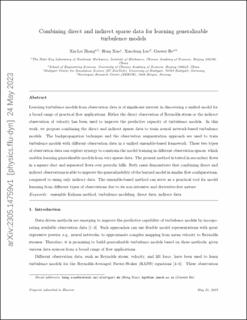| dc.contributor.author | Zhang, Xin-Lei | |
| dc.contributor.author | Xiao, Heng | |
| dc.contributor.author | Luo, Xiaodong | |
| dc.contributor.author | He, Guowei | |
| dc.date.accessioned | 2023-12-12T14:38:38Z | |
| dc.date.available | 2023-12-12T14:38:38Z | |
| dc.date.created | 2023-07-11T15:46:50Z | |
| dc.date.issued | 2023 | |
| dc.identifier.citation | Journal of Computational Physics. 2023, 489 . | |
| dc.identifier.issn | 0021-9991 | |
| dc.identifier.uri | https://hdl.handle.net/11250/3107186 | |
| dc.description.abstract | Learning turbulence models from observation data is of significant interest in discovering a unified model for a broad range of practical flow applications. Either the direct observation of Reynolds stress or the indirect observation of velocity has been used to improve the predictive capacity of turbulence models. In this work, we propose combining the direct and indirect sparse data to train neural network-based turbulence models. The backpropagation technique and the observation augmentation approach are used to train turbulence models with different observation data in a unified ensemble-based framework. These two types of observation data can explore synergy to constrain the model training in different observation spaces, which enables learning generalizable models from very sparse data. The present method is tested in secondary flows in a square duct and separated flows over periodic hills. Both cases demonstrate that combining direct and indirect observations is able to improve the generalizability of the learned model in similar flow configurations, compared to using only indirect data. The ensemble-based method can serve as a practical tool for model learning from different types of observations due to its non-intrusive and derivative-free nature | |
| dc.language.iso | eng | |
| dc.subject | Ensemble based methods | |
| dc.subject | Ensemble-based methods | |
| dc.subject | Turbulens | |
| dc.subject | Turbulence | |
| dc.title | Combining direct and indirect sparse data for learning generalizable turbulence models | |
| dc.title.alternative | Combining direct and indirect sparse data for learning generalizable turbulence models | |
| dc.type | Peer reviewed | |
| dc.type | Journal article | |
| dc.description.version | submittedVersion | |
| cristin.ispublished | true | |
| cristin.fulltext | preprint | |
| cristin.qualitycode | 2 | |
| dc.identifier.doi | 10.1016/j.jcp.2023.112272 | |
| dc.identifier.cristin | 2162012 | |
| dc.source.journal | Journal of Computational Physics | |
| dc.source.volume | 489 | |
| dc.source.pagenumber | 25 | |
| dc.relation.project | Norges forskningsråd: 331644 | |
| dc.relation.project | Andre: National Natural Science Foundation of China, No.11988102 | |
| dc.relation.project | Andre: China Postdoctoral Science Foundation, No. 2021M690154 | |
| dc.relation.project | Andre: National Natural Science Foundation of China, No. 12102435 | |
| dc.subject.nsi | VDP::Fysikk: 430 | |
| dc.subject.nsi | VDP::Physics: 430 | |
